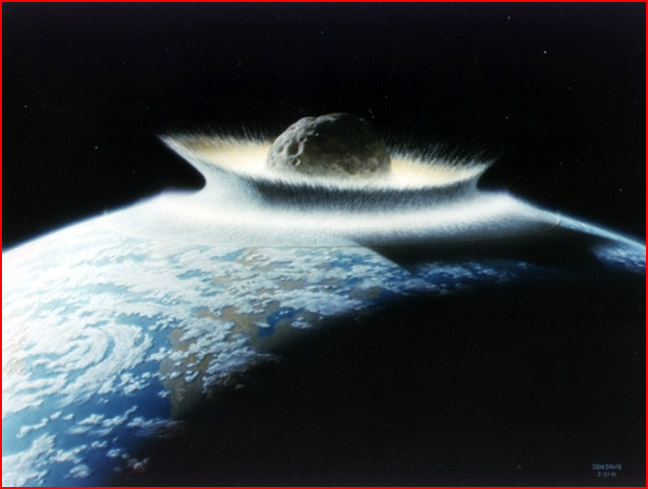
home •
about •
essential guide •
picture of the day •
thunderblogs •
news •
multimedia •
predictions •
products •
get involved •
contact
picture of the day archive subject index
This illustration of an asteroid hitting Earth, produced by a NASA artist, is one of the
most often-published images on the Internet relating to cosmic catastrophe.
Jul 12, 2006
"Doomsday Asteroids" Enchant Astronomers
On July 3, 2006, our planet experienced an astronomical "close brush" with a very large asteroid. Though we were never in danger from the passing body, the near-encounter prompted a series of news reports on the global threat posed by such intruders.The majority of astronomers whom the media interview about cometary or asteroidal threats express the same sentiment: It is not a question of if Earth will be decimated by a giant asteroid, but when. Some remind us of the "wake-up" call provided by Comet Shoemaker-Levy in 1994, when a stream of comet fragments plowed into Jupiter.
NASA and other space agencies around the world have lobbied for increased funding for asteroid defense. From the perspective of most astronomers and planetary scientists, asteroids are the most likely culprits to cause a global extinction event for any planet, including Earth. But when scrutinized, the legitimacy of this concern becomes suspect.
Planetary scientists gaze at the features on rocky bodies in our solar system and see craters—lots and lots of craters. In their thinking, these craters are mostly caused by impacts from intruding bodies. When one looks at the surfaces of the Moon and our planetary neighbors from this perspective, one is left with the impression that asteroids and other impacting bodies are as ubiquitous as they are devastating.
But we should be careful about leaping to such a conclusion. Some bodies in the solar system are so heavily cratered that a special "late, heavy bombardment" had to be included in the speculative history of the solar system. Astronomers are not sure where the “bombarding objects” came from or why the bombardment should have been delayed until planets and moons had solid surfaces. In addition, most planets and moons show mysterious hemispheric differences in cratering. But most telling is the fact that the detailed features of "impact" craters do not match attempts to mimic them in the lab or in powerful explosions.
In fact, our planet may not be so vulnerable to a globally-devastating event as astronomers have led us to believe. From the Electric Universe perspective, as explained by Wallace Thornhill, Earth, the asteroids, and comets are charged bodies moving in the electric field of the Sun. Thornhill believes that the charge difference between these bodies provides the earth with a natural defense against asteroids and comets, particularly very large ones. When an asteroid or comet enters the electric field of the Earth, which is contained within its "magnetosphere," or more accurately-plasma sheath, there will be a powerful discharge between the two bodies. (See earlier TPODs on the Tunguska event and the Chicago Fire.)
The internal electrical stress caused by the discharge of the interloping asteroid or comet will generally cause it to detonate like an exploding capacitor—just as comets have frequently exploded "inexplicably" as they moved toward the Sun on their elongated orbits. (See The Explosive Demise of Comet Linear, and When Comets Break Apart. Also Schwassmann-Wachmann 3 Disintegrates)
Of course, we have already witnessed the electrical destruction of a colliding comet. Comet Shoemaker-Levy fragments were destroyed in a series of brilliant, unexpected flashes high above Jupiter's atmosphere.
This is not to say that the Electric theorists believe comets and asteroids pose no threat to human beings. But the havoc these bodies might wreak would likely be limited to localized disasters—perhaps a series of Tunguska-like events producing regional devastation with falls of sand and dust, perhaps electrical craters, fires and earthquakes, but no single impact crater at all. The devastation of a global extinction requires an encounter with something much larger than a puny comet or asteroid. In all likelihood, it requires electrical exchanges with a body the size of a planet.
It seems that our catastrophic prehistory is still expressed today in an irrational fear of "doomsday from the heavens". The irrational component in this fear is its focus on unsubstantiated theory with scant regard for the true nature of the ancient anxiety. No one has witnessed a "killer asteroid" hitting a rocky planet, and there is no proof that so-called "impact craters" were formed by impacts at all. An electrical perspective emphasizes that circular craters, including features that cannot be produced by impact, are a natural form of electric scarring. And what happened at Jupiter (Shoemaker-Levy) did not illustrate a "pie in the face" collision, but the planet’s electrical “defense system.”
There can be no question that our planet has suffered immense catastrophes in the past. But the electrical theorists suggest that the apocalyptic visions of astronomers are largely a contrivance of over-hyped theory and excessive media attention—an avenue more useful for generating funding than for promoting human understanding.
___________________________________________________________________________Please visit our Forum
The Electric Sky and The Electric Universe available now!

|
|

|
EXECUTIVE EDITORS:
David Talbott, Wallace Thornhill
MANAGING EDITORS:
Steve Smith, Mel Acheson
CONTRIBUTING EDITORS: Dwardu Cardona, Ev Cochrane,
C.J. Ransom, Don Scott, Rens van der Sluijs, Ian Tresman
WEBMASTER: Brian Talbott
Copyright 2006: thunderbolts.info
![]()
home •
thunderblogs •
forum •
picture of the day •
resources •
team •
updates •
contact us

